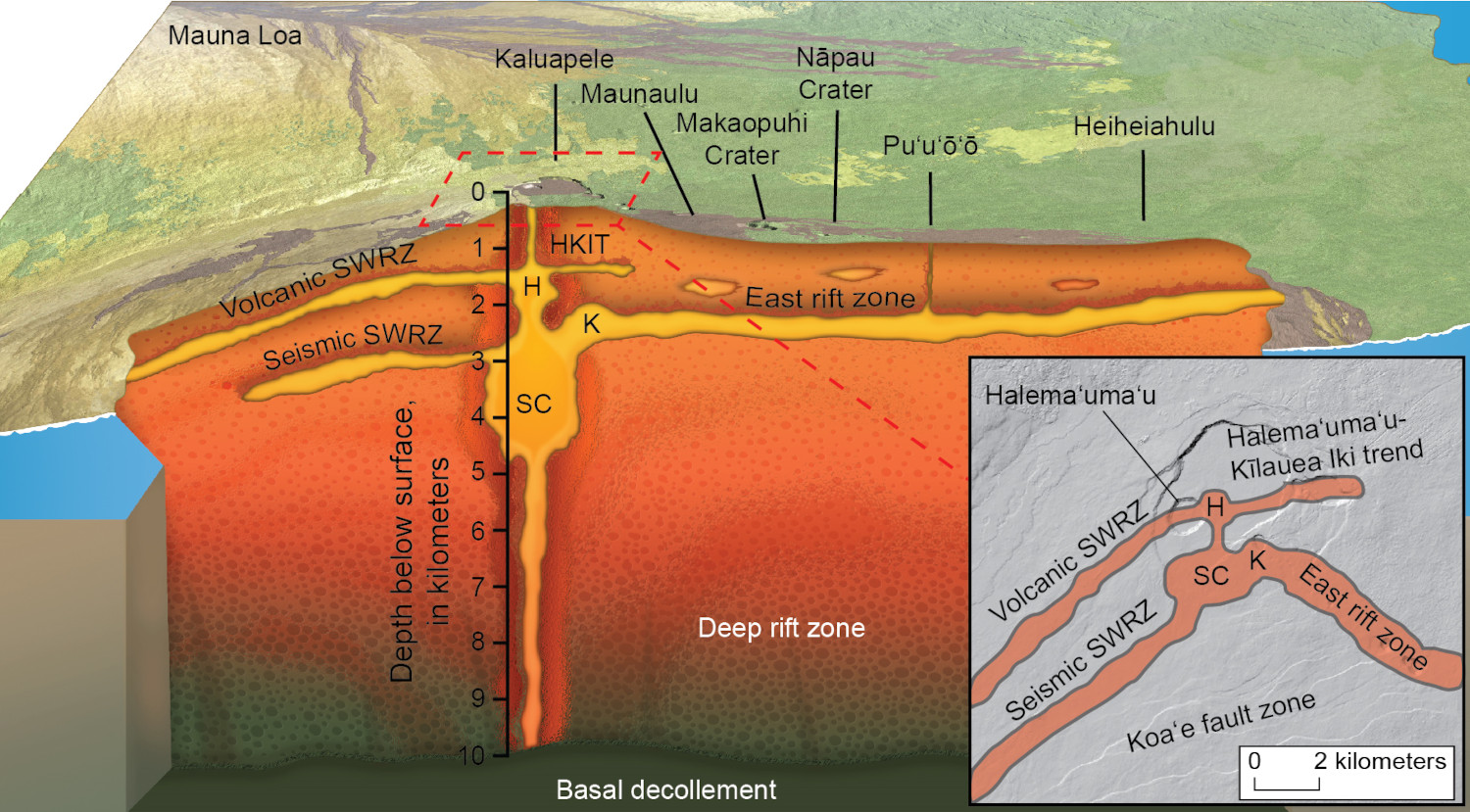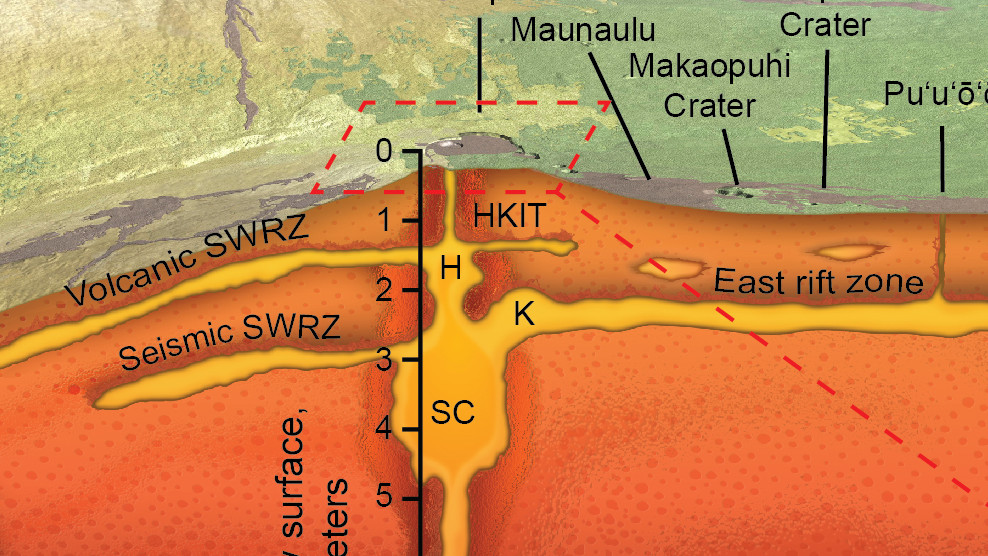(BIVN) – From this week’s Volcano Watch article, written by U.S. Geological Survey Hawaiian Volcano Observatory scientists and affiliates:
Over the past several months, periods of increased earthquake activity and ground deformation in the summit region of Kīlauea volcano indicate that magma is accumulating beneath the surface. Where does magma reside, and how do we know?
First, let’s envision what a region of magma storage might look like. The top of an active magma chamber is hot with liquid rock. Deeper in the chamber, it transitions to slightly cooler, partially molten/partially solid, crystal-rich material, and eventually to relatively cold and brittle rock. The amount of magma in a reservoir fluctuates over time—there may be variations in the amount of magma coming into the reservoir from the hot spot or differences in the amount of magma being removed, due to eruptions or intrusions.
Fluctuations in the amount of magma in a reservoir cause changes in pressure that we can detect by earthquakes and ground deformation. Earthquakes don’t occur in liquids (such as magma), but their locations in cooler brittle rocks can approximately outline storage zones. Earthquakes also occur over a wider area of the volcano because of changing stresses from magma pressure and gravitational forces.
Along with earthquakes, the behavior of the ground surface above an area of magma storage can be an important indicator of conditions in the magma reservoir. When more or less magma is being stored, the ground surface above will move. Small changes in the ground’s surface are recorded by instruments on the ground, and also by satellite.
Earthquake locations and patterns of ground deformation give us clues as to where and how much magma is stored beneath the surface. The size, location, and number of earthquakes, along with the area and amount of ground deformation, can be used to model the depth and volume of magma storage regions.

USGS: “A cross section of proposed magma plumbing system beneath the surface of Kīlauea. “H” marks the Halema‘uma‘u reservoir; “SC” marks the south caldera reservoir; “K” marks the Keanakāko‘i reservoir; “HKIT” notes a connection between the Halema‘uma‘u reservoir and Kīlauea Iki; SWRZ denotes Southwest Rift Zone. The exact depths and geometries of these connections are not well known, but this cross section represents one of the hypothesized configurations.”
At Kīlauea, there are several storage regions hypothesized from decades of monitoring data. Magma is stored in the Halema‘uma‘u reservoir, which lies about one mile (1–2 km) below the crater. Deflation-inflation (DI) events recorded by the tiltmeter near Uēkahuna bluff, in Hawai‘i Volcanoes National Park, are thought to show changes in pressurization of this magma storage region, and this reservoir can drain during intrusions and eruptions. For example, the lower East Rift Zone eruption in 2018 removed so much magma from the Halema‘uma‘u reservoir that the summit caldera collapsed!
Another shallow reservoir, which is only intermittently active, is located near Keanakāko‘i. There is also probably some magma stored in the Halema‘uma‘u-Kīlauea Iki trend about a mile (1-2 km) of the surface, connecting the Halema‘uma‘u reservoir to Kīlauea Iki. The September 2023 eruption occurred from this system.
Below the Halema‘uma‘u reservoir and slightly to the south is the larger main magma chamber for Kīlauea, referred to as the south caldera reservoir. This body of magma is a couple of miles below the ground surface (3-5 km); it is fed by the hot spot and feeds the shallower Halema‘uma‘u reservoir, although the two reservoirs sometimes act independently, so the connection is not perfect. The south caldera reservoir also supplies magma to Kīlauea’s main rift zones.
Magma can also be stored in an area referred to as the seismic Southwest Rift Zone, which lies about 2 miles (3 km) beneath the surface between Kīlauea caldera and the Koa‘e Fault System. Episodes of magma accumulation in this region are frequent—for example, in 2006, 2015, 2021, and during October–November 2023; eruptions from this area, however, are rare.
Earthquake locations and patterns of ground deformation over the past several months suggest that several zones of magma accumulation at the summit have been recently active. In addition to the Halema‘uma‘u and south caldera reservoirs, magma appears to be leaking into the Keanakāko‘i and seismic Southwest Rift Zone.
Why certain magma storage regions activate over others is not well-understood, but recent observations continue to suggest that the summit of Kīlauea is becoming increasingly pressurized over time. The USGS Hawaiian Volcano Observatory is closely monitoring this activity.
January is Volcano Awareness Month on the Island of Hawai‘i! Join us this coming week at one of the several events occurring; the full schedule is available here.



by Big Island Video News9:49 pm
on at
STORY SUMMARY
ISLAND OF HAWAIʻI - Hawaiian Volcano Observatory scientists envision what the Kilauea magma chamber complex might look like, deep under the volcano surface.